Scottish sea fisheries statistics 2016
Annual National Statistics report on the quantity and value of landings of sea fish and shellfish by Scottish vessels and landings into Scotland.
This document is part of a collection
1. Overview of landings
This chapter brings together information on the quantity, value, species and area of capture of sea fish landings. The focus is on Scottish based vessels and landings into Scotland.
1.1 Landings by Scottish based vessels
In 2016, Scottish based vessels landed 453 thousand tonnes of sea fish and shellfish into the UK and abroad with a value of £557 million ( Table 1.1.e and Chart 1.1.). This represents a three per cent increase in quantity and a 25 per cent increase in value in real terms compared to 2015.
Chart 1.1 Quantity and value of all landings by Scottish vessels: 2012 to 2016
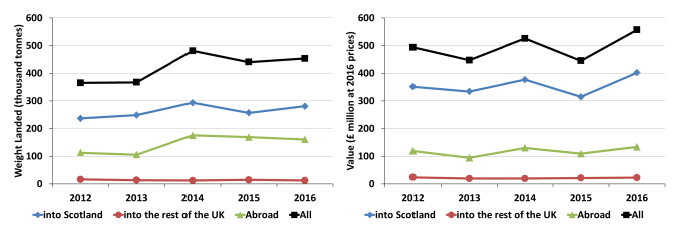
Landings by Scottish vessels accounted for 59 per cent of the value and 65 per cent of the quantity of all landings by UK vessels ( Tables 1.1.e, 1.1.o and 1.1.v). Since 2015, both these percentage shares have increased by three percentage points.
1.1.1 Demersal, pelagic and shellfish landings by Scottish based vessels
In 2016, 294 thousand tonnes of pelagic species were landed by Scottish vessels with a value of £222 million. This accounted for 65 per cent of all landings by Scottish vessels in terms of quantity and 40 per cent in terms of value. Demersal species represented 21 per cent of the quantity of all landings (95 thousand tonnes) and 30 per cent of the value (£169 million), while shellfish landings accounted for 14 per cent of landings by quantity (64 thousand tonnes) and 30 per cent by value (£166 million) (Chart 1.2).
Chart 1.2 Quantity and value of landings by Scottish vessels; percentage of each species type, 2016
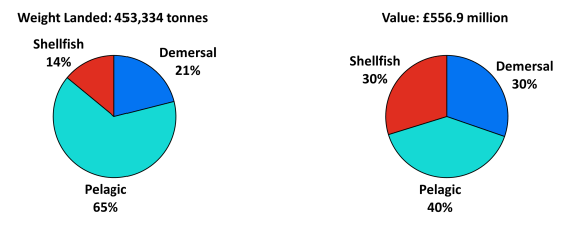
The 25 per cent increase in the value of landings by Scottish registered vessels between 2015 and 2016 was driven by increases in all three species types (Chart 1.3). In real terms the value of pelagic landings decreased by 36 per cent from 2015 and shellfish landings increased by 21 per cent and demersal landings increased by 16 per cent. In real terms the total increase in value from 2015 was £112 million.
The increase in value of mackerel and herring landings accounts for the increase in the value of pelagic fish landings. The value of pelagic landings increased by 36 per cent (£59 million). Mackerel is the most valuable species to the Scottish fishing industry, accounting for 30 per cent of the total value of Scottish landings in 2016 and 76 per cent of the value of pelagic landings. The value of mackerel in real terms rose 27 per cent from 2015. Despite the quantity landed decreasing by 6 per cent, the average price of mackerel increased by 35 per cent, from £664 per tonne in 2015 to £895 per tonne in 2016.
Herring, which accounts for eight per cent of the total value of Scottish landings and 20 per cent of the total pelagic landings in 2016, increased in value in real terms by 101 per cent, and the quantity landed increased by 12 per cent since 2015. The price per tonne of herring increasing by 80 per cent, from £369 per tonne to £665 per tonne.
In 2016, the value of shellfish species increased in real terms by 21 per cent (£29 million), and the quantity of shellfish landed increasing by ten per cent from 2015. Nephrops are the most valuable shellfish stock to the Scottish fishing industry, representing 14 per cent of the total value of Scottish landings in 2016 and 46 per cent of the value of shellfish landings. The value in real terms of Nephrops increased by 24 per cent and the quantity landed of Nephrops increased by 27 per cent from 2015, however the price per tonne decreased by three per cent, from £3,761 per tonne to £3,645 per tonne.
The value of demersal species increased in real terms by 16 per cent (£23 million) since 2015. The value of monkfish, which represents six per cent of the total value of Scottish landings in 2016 and 21 per cent of the value of demersal landings, increased in real terms by 30 per cent, further the price per tonne increased by 14 per cent, from £2,401 per tonne to £2,742 per tonne. The quantity of monkfish landed increased by 14 per cent. Haddock which represents seven per cent of the total value of Scottish landings in 2015 and 22 per cent of the value of demersal landings, decreased in real terms by one per cent. There was a three per cent increase in quantity landed and a four per cent decrease in the price per tonne, from £1,386 per tonne to £1,332 per tonne.
Chart 1.3 Quantity and value of landings by Scottish vessels by each species type; 2012 to 2016

Chart 1.4 Percentage change from 2015 to 2016 in the real term price per tonne obtained for key fish species
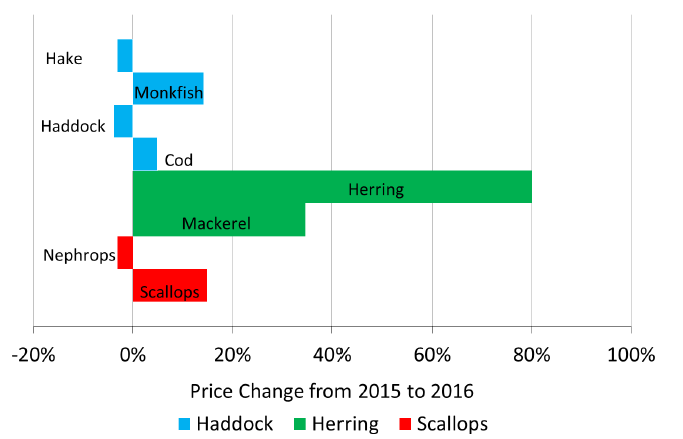
Prices of fish in 2016 and other years in real terms can be found in Table 1.1.x.
A breakdown of landings by Scottish vessels into Scotland, the rest of the UK, and abroad, by species are given in Tables 1.1.a to 1.1.e as well as corresponding figures for other UK vessels in Tables 1.1.f to 1.1.o, and figures for foreign vessels landings into the UK in Tables 1.1.p to 1.1.t.
Demersal fish
Demersal species contributed 30 per cent of the overall value of all landings by Scottish vessels in 2016 and increased in real terms by 16 per cent from 2015. The total quantity of demersal species landed by Scottish vessels increased by five per cent from 2015. Demersal species contributed 21 per cent of total quantity landed by Scottish vessels. Haddock accounts for 30 per cent, cod 14 per cent, monkfish 13 per cent and hake, saithe and whiting are each eight per cent of all demersal species landed by Scottish vessels in 2016 in terms of tonnage weight.
Haddock, monkfish and cod are the three main demersal fish species landed by Scottish vessels in terms of value, accounting for 22 per cent, 21 per cent and 16 per cent respectively of the total value of demersal species landed in 2016. The value of demersal species increased by 16 per cent in real terms from 2015 and there was an increase of five per cent in the quantity landed. This increase was driven by increased value in real terms for a variety of species – plaice (rose 63% to £7.5 million), monkfish (rose 30 per cent to £34.7 million), cod (rose 19 per cent to £27.4 million), hake (rose 14 per cent to £18.4 million) and saithe (rose 12 per cent to £8.2 million). Haddock decreased in real terms by one per cent to £37 million and whiting decreased by seven per cent to £8.1 million. (Chart 1.5.a).
The increase in value in real terms for plaice was due to a 24 per cent increase in price per tonne from £989 to £1,231 and a 31 per cent increase in the quantity of plaice landed in 2016. Monkfish increased in price per tonne by 14 per cent from £2,401 to £2,742 and a 14 per cent increase in the quantity of monkfish landed in 2016. The price of megrim increased by 13 per cent increase £2,519 per tonne to £2,853 per tonne and quantity landed increased by 12 per cent compared to 2015. Cod increased in value in real terms by five per cent, with the average price increasing from £2,003 per tonne to £2,101 per tonne. The quantity of cod landed increased by 13 per cent, to 13 thousand tonnes. Haddock decreased in real terms by four per cent from £1,386 per tonne to £1,332 per tonne, despite an increase of three per cent in quantity landed in 2016. From the real term prices per tonne ( Table 1.1.x and Chart 1.4), most demersal species showed an increase in price from 2015, any decreases were slight.
Chart 1.5.a Quantity and value of landings of the key demersal species by Scottish vessels: 2012 to 2016
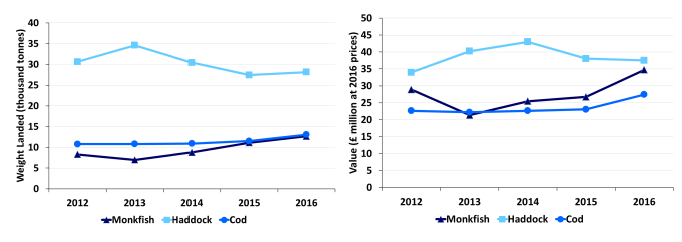
Pelagic fish
Mackerel and herring are the two main pelagic fish landed by Scottish vessels both in terms of quantity and value. In 2016 the total quantity of pelagic species landed by Scottish vessels increased by one per cent from 2015 and the value increased in real terms by 36 per cent. Mackerel, the stock with the largest landings by the Scottish fishing fleet, accounted for 76 per cent of the value and 64 per cent of the quantity of all the pelagic landings by Scottish vessel. Herring accounted for 20 per cent of the value and 22 per cent of the quantity, of all the pelagic landings by Scottish vessels in 2016.
From 2015 to 2016, the value of mackerel in real terms increased by 27 per cent to £169 million and the quantity of landings decreased by six per cent to 188 thousand tonnes (Chart 1.5.b). The price per tonne for mackerel increased 35 per cent (Chart 1.4), up from £664 per tonne to £895 per tonne. The value in real terms of herring increased by 101 per cent to £43.6 million, and the quantity of landings increased 12 per cent to 65.5 thousand tonnes. This change in value was largely due to the 80 per cent increase in price per tonne for herring, from £363 per tonne to £665 per tonne.
Chart 1.5.b Quantity and value of landings of the key pelagic species by Scottish vessels: 2012 to 2016
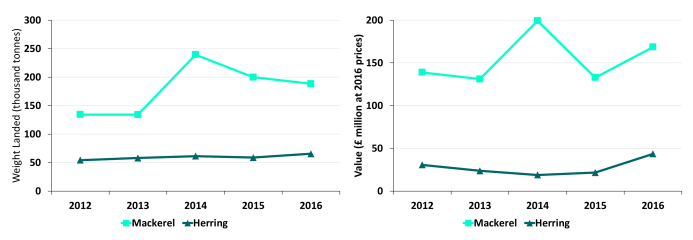
Shellfish
Nephrops and scallops are the two main species of shellfish landed by Scottish vessels. In 2016 the total quantity of shellfish species landed by Scottish vessels increased by ten per cent from 2015 and the value increased in real terms by 21 per cent. Nephrops accounted for 46 per cent of the value and 33 per cent of the quantity of shellfish landed by Scottish vessels in 2016. Scallop landings accounted for 22 per cent of the value and 24 per cent of the quantity of all shellfish landings by Scottish vessels.
Nephrops are the most valuable shellfish species to the Scottish fishing industry, worth £77 million in 2016 and accounting for 14 per cent of the total value of all Scottish landings. The value of Nephrops landings by Scottish vessels increased by 24 per cent in real terms from 2015. This increase in value was driven by a 27 per cent increase in the quantity landed, to 21 thousand tonnes. The price per tonne for Nephrops decreased by three per cent, from £3,761 per tonne to £3,645 per tonne.
In 2016, the value of scallops in real terms increased by ten per cent from 2015 to £37 million. This increase in value occurred despite a four per cent fall in the quantity of scallop landings, to 15,340 thousand tonnes. The decrease in quantity was offset by a 15 per cent increase in the average price, from £2,098 per tonne to £2,411 per tonne.
The value of edible crabs, lobsters, squid and velvet crabs increased in real terms between 2015 and 2016, along with the quantity landed. The quantity landed of edible crabs increased by 12 per cent from 2015 and the value in real terms increased by 21 per cent. The quantity of lobsters increased by ten per cent and the value in real terms increased by 22 per cent. The quantity of squid landed increased by 26 per cent and value in real terms increased by 50 per cent. Velvet crabs had an eight per cent increase in the quantity landed and an increase of 16 per cent in the value in real terms. Whelks had a 52 per cent increase in the quantity landed and an increase of 63 per cent in the value.
The increases in quantity and value were reflected in the price per tonne for these species. Edible crabs rose by eight per cent in real terms to £1,370 per tonne. Lobsters rose by 11 per cent in real terms to £11,973. Squid rose by 20 per cent in real terms to £3,837. Velvet crabs rose by seven per cent in real terms to £2,767.
Chart 1.5.c Quantity and value of landings of the key shellfish species by Scottish vessels: 2012 to 2016

1.2 Landings abroad by Scottish based vessels
In 2016, Scottish vessels landed 160 thousand tonnes of sea fish and shellfish abroad with a corresponding value of £133 million. The quantity of landings abroad decreased by five per cent and the value of landings abroad increased by 22 per cent in real terms since 2015. Apart from Spain, Norway and other non- EU countries, landings abroad by Scottish vessels have increased both in quantity and value during 2016 ( Table 1.1.d and 1.3). Although landings into Norway decreased in quantity by eight per cent, the value of these landings have increased by 25 per cent from 2015.
Landings abroad accounted for 35 per cent of all landings by Scottish vessels in terms of quantity and 24 per cent in terms of value. Of this, 94 per cent of the quantity of landings abroad was pelagic, five per cent were demersal and less than half of one per cent was shellfish. The main species landed abroad was mackerel, with a value of £86 million this represents 65 per cent of the total value of fish landed abroad in 2016. Since 2015, mackerel landings abroad have decreased in quantity by 18 per cent and increased in value in real terms by 13 per cent. There were 92.4 thousand tonnes of mackerel landed abroad, which is 49 per cent of the total quantity of mackerel landed by Scottish vessels. The price for mackerel landed into the UK in 2016 was, on average, £852 per tonne, while mackerel landed abroad received an average of £936 per tonne.
The majority of Scottish landings abroad were into Norway, and nearly all of these landings are pelagic species. In 2016, 79 per cent of the value of landings into Norway was for mackerel, amounting to 81 thousand tonnes with a value of £76 million. Herring accounted for 21 per cent of the value of landings into Norway, amounting to 29 thousand tonnes with a value of £20 million. The key countries for demersal landings were Netherlands, Ireland and Denmark. Scottish vessels landed nine thousand tonnes of demersal species abroad with a value of £16 million. Only 0.5 thousand tonnes of shellfish were landed abroad by Scottish vessels in 2016, mainly into Ireland and Denmark.
Figure 1.1.a Quantity of landings abroad by Scottish vessels by country of landing: 2016 (tonnes)

Figure 1.1.b Value of landings abroad by Scottish vessels by country of landing: 2016 (£’ thousands)

1.3 Landings by area of capture
Scottish vessels were most active in two main ICES areas during 2016. These were the Northern North Sea ( ICES division IVa) and the West Coast of Scotland ( ICES division VIa) (Figures 1.2.a and 1.2.b). In the Northern North Sea (IVa), 231 thousand tonnes of sea fish and shellfish were caught with a value of £289 million, representing 51 per cent of the quantity and 52 per cent of the value of all landings by Scottish vessels ( Table 1.6). Just over a third (35 per cent) of landings by Scottish vessels in terms of quantity was caught in the West Coast of Scotland (VIa), providing 32 per cent of the total value of all Scottish landings.
Seventy per cent of the quantity of all demersal landings by Scottish vessels was caught in the Northern North Sea (IVa). Of the total quantity of pelagic landings, 51 per cent were caught in the Northern North Sea (IVa) and 41 per cent were caught in the West Coast of Scotland (VIa). More shellfish species were caught in the West Coast than in the Northern North Sea. In terms of quantity, shellfish catches from the West of Scotland accounted for 38 per cent of all shellfish landings, whereas 25 per cent of shellfish landings were caught in the Northern North Sea (IVa). The Central North Sea ( ICES division IVb) and the Irish Sea (VIIa) are also areas of considerable activity for shellfish fisheries. Fifteen per cent of shellfish catches are from the Central North Sea (IVb) and 16 per cent are from the Irish Sea (VIIa), where almost all catches from the Irish Sea are of shellfish species. The rest of Area VII (i.e. not the Irish Sea) had four per cent activity from demersal, six per cent activity from pelagic and shellfish vessels, with six per cent of the quantity of all landings being caught in this area.
Further data on fishing activity in the seas around the UK by Scottish vessels, other UK vessels, and foreign vessels that land into the UK will be available on the ICES rectangle webpage on the Scottish Sea Fisheries Statistics website. This data shows the quantity and value of landings by species type by ICES rectangle. Further maps on fishing activity in Scottish waters by Scottish vessels, other UK vessels, and foreign vessels that land into the UK will be available on the National Marine Plan Interactive (NMPi) webpage.
Figure 1.2.a Quantity of landings by Scottish vessels by area of capture: 2016 (tonnes)

Figure 1.2.b Value of landings by Scottish vessels by area of capture: 2016 (£’thousand)

1.4 Landings into Scotland
In 2016, there was 349 thousand tonnes of sea fish and shellfish landed into Scotland with a value of £506 million. This represents an 11 per cent increase in quantity and a 27 per cent increase in value in real terms since 2015. Landings of demersal species accounted for 46 per cent, shellfish species 30 per cent and pelagic species 24 per cent of the total value of all landings into Scotland. However, in terms of quantity, 46 per cent of landings into Scotland were pelagic, 38 per cent were demersal and 16 per cent were shellfish species. The differences in how each species type contributed to the total value and total quantity of landings into Scotland highlights the differences between the prices per tonne across the species types. Shellfish receive relatively high prices per tonne, whilst pelagic species receive lower prices per tonne ( Table 1.1.s).
Figure 1.3.a and b and Table 1.7 show landings by all vessels by species type into the eighteen Scottish districts. Landings into the south-west coast and south-east coast were dominated by shellfish, while landings into the north-west coast constituted both demersal and, to a lesser extent, shellfish species. The three largest districts in Scotland in terms of quantity of landings were Peterhead (east coast), Shetland (north) and Fraserburgh (east coast). These districts receive landings of all three species types, although Peterhead and Shetland receive relatively small amounts of shellfish compared to demersal and pelagic species.
Combined, the top three districts accounted for 74 per cent in quantity and 57 per cent in value of all landings into Scotland. Peterhead saw 161 thousand tonnes landed in 2016, with a value of £174 million. In terms of quantity, 61 per cent of the landings into Peterhead were of pelagic species which accounted for 40 per cent of the landings value. In contrast, 36 per cent of the quantity of landings into Peterhead was of demersal species which accounted for 52 per cent of the value.
Landings into Shetland totalled 72 thousand tonnes and were valued at £79 million. As with Peterhead, the majority of landings into Shetland were of pelagic species, which represented 69 per cent of the total quantity and 52 per cent of the total value of landings. Demersal species accounted for 26 per cent of the quantity and 42 per cent of the value landed into Shetland. Landings into Fraserburgh totalled 23 thousand tonnes and were valued at £38 million. The distribution of landings differs from Peterhead and Shetland, the larger of landings were of pelagic species, which represented 46 per cent of the total quantity and 22 per cent of the total value of landings. Demersal species accounted for 30 per cent of the quantity and 28 per cent of the value landed into Shetland. Whereas shellfish species accounted for 24 per cent of the quantity and 50 per cent of the value.
Most of the districts reported an increase in quantity and value of landings in 2016. Aberdeen reported a nine per cent decrease in quantity but an 11 per cent increase in value from 2015. Shetland reported a one per cent decrease in quantity but a 30 per cent increase in value from 2015. Ullapool reported a seven per cent increase in quantity but a three per cent decrease in value from 2015.
Figure 1.3.a Quantity of landings into Scotland by all vessels by district: 2016 (tonnes))

Figure 1.3.b Value of landings into Scotland by all vessels by district: 2016 (£’thousand)

1.5 Total allowable catches quota and uptake
Table 1.10 shows the total allowable catch ( TAC) for stocks. TACs are a catch limit set for individual stocks and are fixed on an annual basis at international negotiations. Some stocks are managed and fished only by European Union ( EU) member states and the TACs for these are set by the European Council through internal negotiations between those EU member states with an interest. Other stocks are managed and shared with non- EU states and TACs for these are set at separate negotiations with interested parties, particularly Norway, Iceland, the Faroe Islands and the Russian Federation (the ‘Coastal States’).
The EU TAC is shared among EU member states based on a number of factors, including each member state’s past catch record. This share, known as quota, is displayed in Table 1.10 at the UK and at the Scottish Producers Organisations ( POs) level. The quantity and percentage uptake of this quota is also given for each stock in Table 1.10.
Chart 1.6 compares the quota uptake of important demersal and pelagic stocks in Scottish Producer Organisations in 2016 and 2015. North Sea monkfish exceeded 100 per cent quota uptake and North Sea cod and NS whiting both reached 99 per cent. North Sea saithe exceeded 98 per cent quota uptake, while North Sea Nephrops reached 84 per cent. At the end of 2016, North Sea haddock quota uptake was 59 per cent, 24 percentage points lower than 2015. This apparent reduction of uptake of NS Haddock was due to an error in the 2015 scientific advice which led to an increase of 30% in the TAC in 2016. When ICES subsequently corrected the error, it emerged that the increase in 2016 should have been 2%, against which catches recorded would have given a more typical uptake comparable with previous years.
In the West of Scotland, monkfish and saithe both exceeded 98 per cent quota uptake, while Nephrops quota uptake exceeded 88 per cent. At the end of 2016, West of Scotland haddock quota uptake was 71 per cent, 26 percentage points lower than 2015. Quota uptake exceeded 100 per cent for North Sea and West of Scotland mackerel and herring.
Chart 1.6 Quota uptakes of important stocks by vessels in Scottish POs in 2015 and 2016

Contact
Email: Valerie West
Phone: 0300 244 4000 – Central Enquiry Unit
The Scottish Government
St Andrew's House
Regent Road
Edinburgh
EH1 3DG
There is a problem
Thanks for your feedback